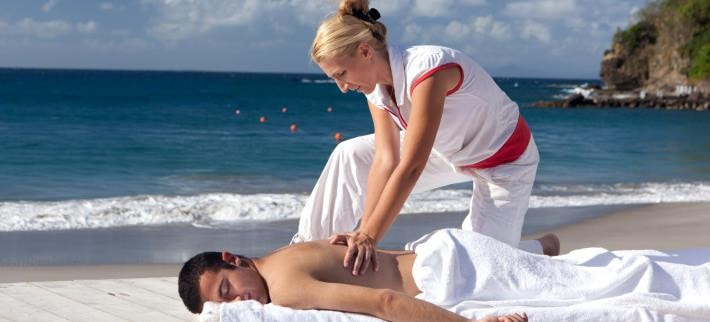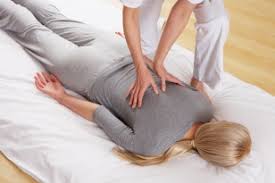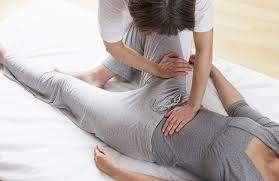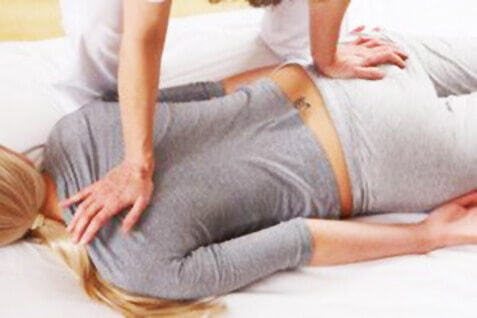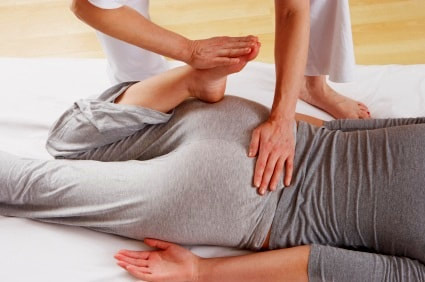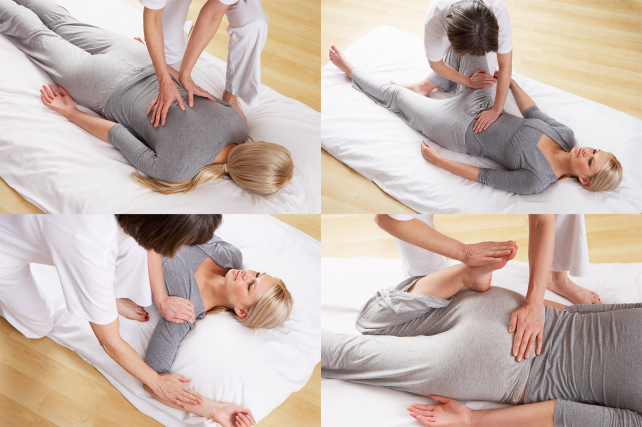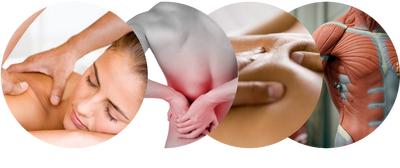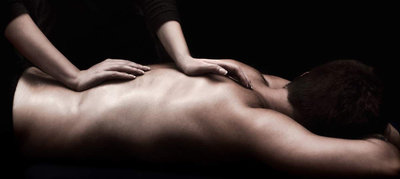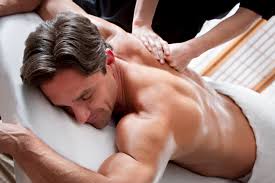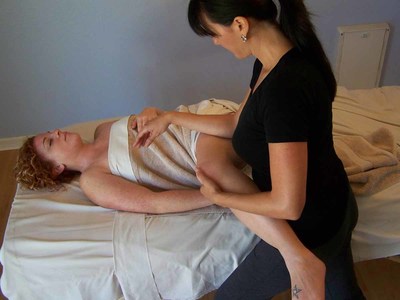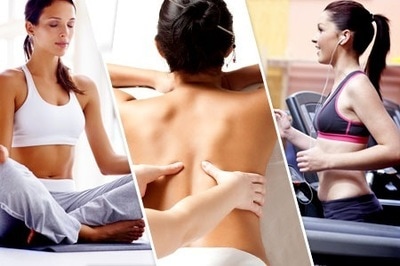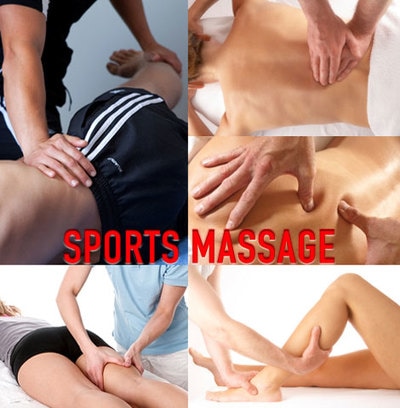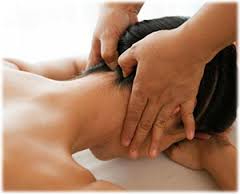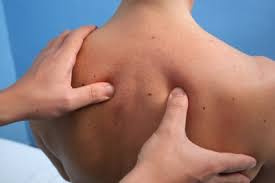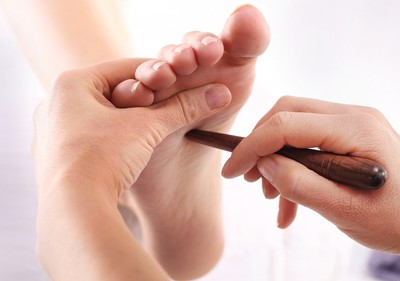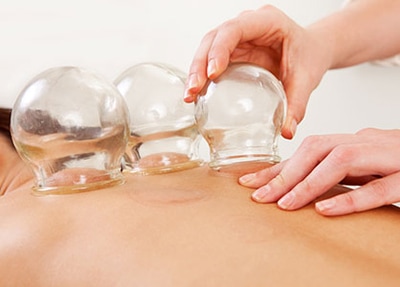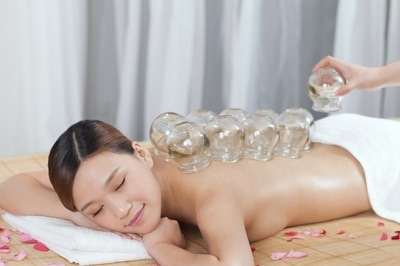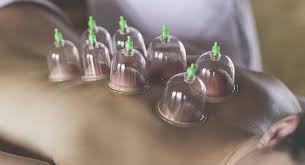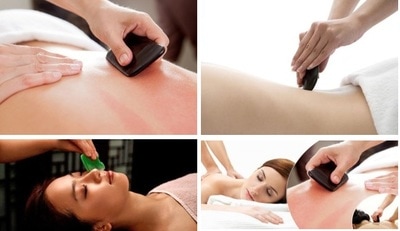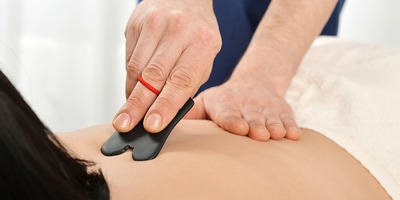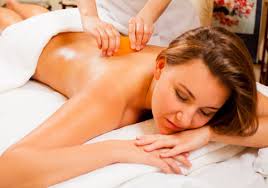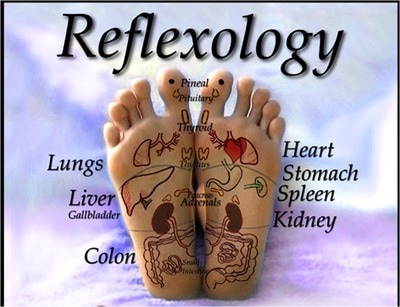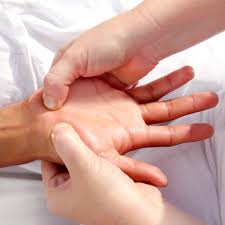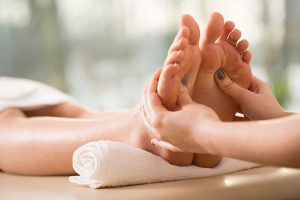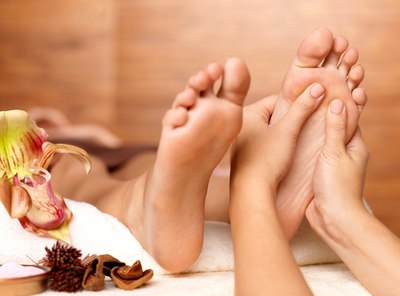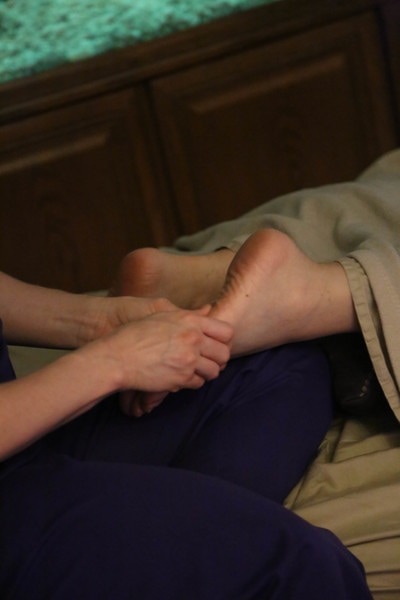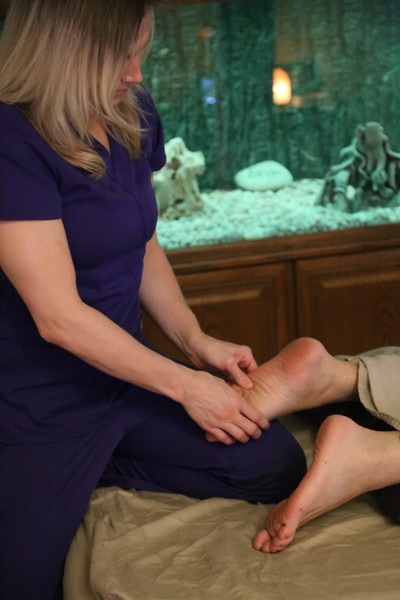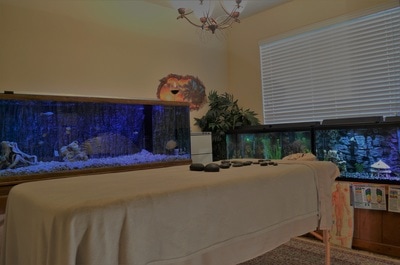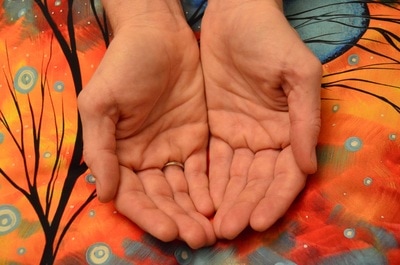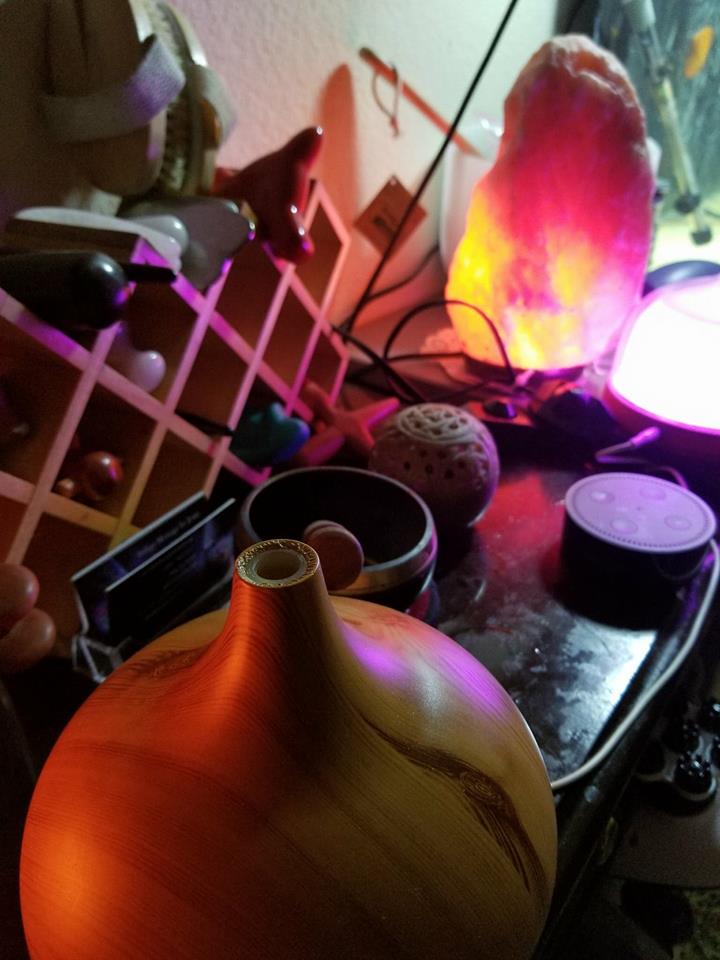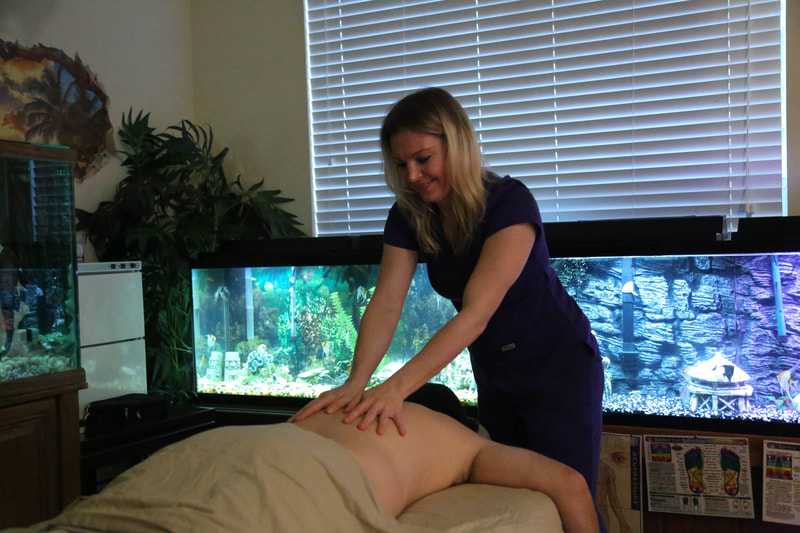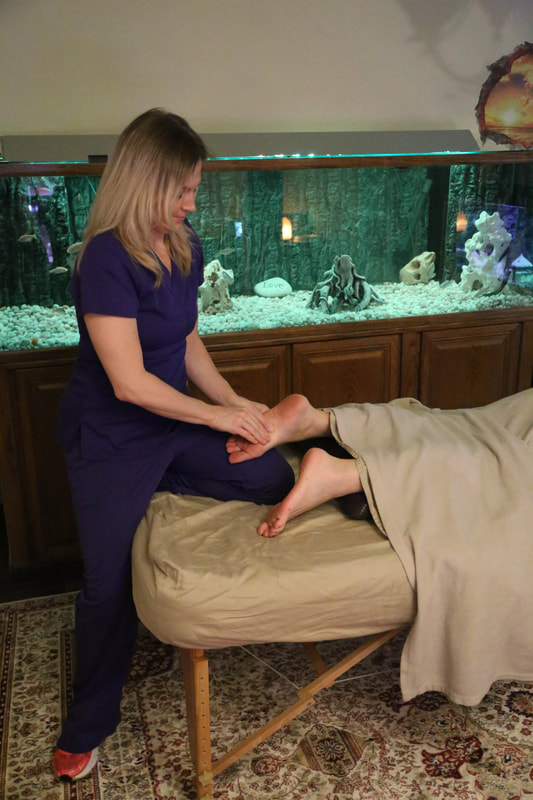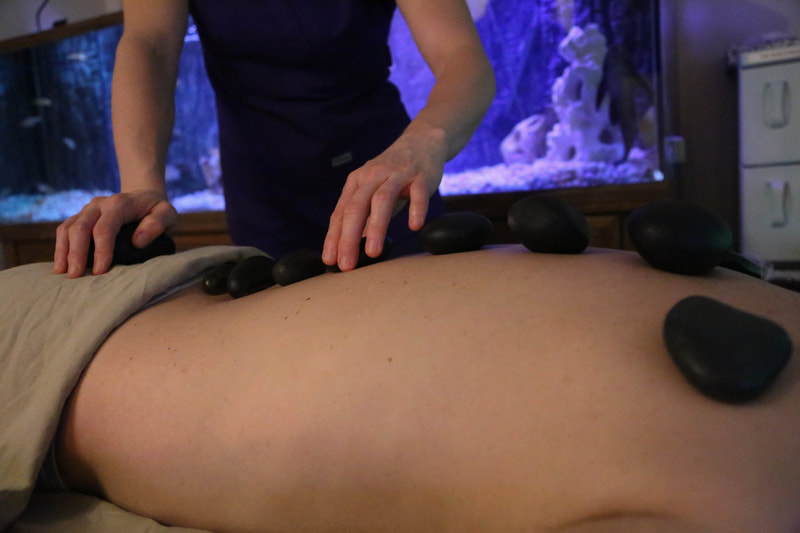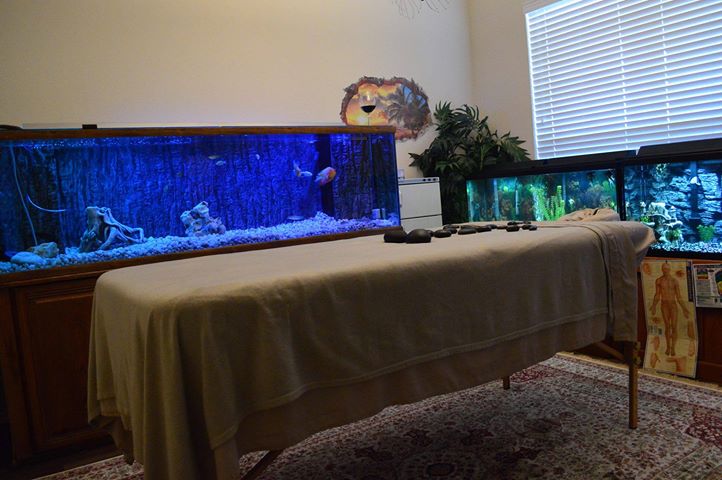Basic Massage Therapy Modalities
Deep Tissue Massage
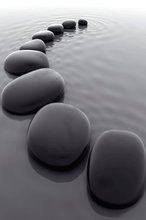
Deep tissue massage is a technique that focuses primarily on the deeper layers of muscles and the fascia. Sometimes this technique involves the therapist using firmer pressure in order to reach these key areas and get them to release, which is why this particular massage is oftentimes recommended for people who are comfortable with a slightly more intense touch. However, deep tissue massage can also refer to gentle yet sustained pressure targeting the myofascial layer. The belief that deep pressure equals pain is a myth; however, the benefits of deep tissue massage are beyond question.
Deep tissue massage is best for giving attention to certain painful, stiff "trouble spots" in your body. The massage therapist uses slow, deliberate strokes that focus pressure on layers of muscles, tendons, or other tissues deep under your skin. Though less rhythmic than other types of massage, deep tissue massage can be quite therapeutic -- relieving chronic patterns of tension and helping with muscle injuries, such as back sprain.
Deep tissue massage therapy is similar to Swedish massage, but the deeper pressure is beneficial in releasing chronic muscle tension. The focus is on the deepest layers of muscle tissue, tendons and fascia (the protective layer surrounding muscles, bones and joints). It's used for chronic aches and pain and contracted areas such as a stiff neck and upper back, low back pain, leg muscle tightness, and sore shoulders.
Deep tissue massage is best for giving attention to certain painful, stiff "trouble spots" in your body. The massage therapist uses slow, deliberate strokes that focus pressure on layers of muscles, tendons, or other tissues deep under your skin. Though less rhythmic than other types of massage, deep tissue massage can be quite therapeutic -- relieving chronic patterns of tension and helping with muscle injuries, such as back sprain.
Deep tissue massage therapy is similar to Swedish massage, but the deeper pressure is beneficial in releasing chronic muscle tension. The focus is on the deepest layers of muscle tissue, tendons and fascia (the protective layer surrounding muscles, bones and joints). It's used for chronic aches and pain and contracted areas such as a stiff neck and upper back, low back pain, leg muscle tightness, and sore shoulders.
Swedish massage

Swedish massage therapy is the modality that comes to mind when most people think about massage. As the best-known type of bodywork performed today, one of the primary goals of the Swedish massage technique is to relax the entire body. This is accomplished by rubbing the muscles with long gliding strokes in the direction of blood returning to the heart. It involves soft, long, kneading strokes, as well as light, rhythmic, tapping strokes, on topmost layers of muscles. This is also combined with movement of the joints. By relieving muscle tension, Swedish therapy can be both relaxing and energizing. This is a very relaxing and therapeutic massage with soft, gentle strokes that promote deep relaxation and relieves tension and stress. But Swedish massage therapy goes beyond relaxation. It may even help after an injury.Swedish massage is exceptionally beneficial for increasing the level of oxygen in the blood, decreasing muscle toxins, improving circulation and flexibility while easing tension.
A study conducted by the National Center for Complementary and Alternative Medicine, and published in The New York Times, found that volunteers who received a 45-minute Swedish massage experienced significant decreases in levels of the stress hormone cortisol, as well as arginine vasopressin-a hormone that can lead to increases in cortisol. Volunteers also had increases in the number of lymphocytes, white blood cells that are part of the immune system, and a boost in the immune cells that may help fight colds and the flu.
Swedish massage techniques include circular pressure applied by the hands and palms, firm kneading, percussion-like tapping, bending and stretching. Before and during your Swedish massage session, communication is encouraged with your professional massage therapist so that your massage is customized to your specific needs.
The four common strokes of Swedish massage are:
1. Effleurage: a smooth, gliding stroke used to relax soft tissue
2. Petrissage: the squeezing, rolling, or kneading that follows effleurage
3. Friction: deep, circular movements that cause layers of tissue to rub against each other, helping to increase blood flow and break down scar tissue
4. Tapotement: a short, alternating tap done with cupped hands, fingers, or the edge of the hand
Please be sure to communicate with your therapist the levels of pressure you prefer.. We try but we are not mind readers!
A study conducted by the National Center for Complementary and Alternative Medicine, and published in The New York Times, found that volunteers who received a 45-minute Swedish massage experienced significant decreases in levels of the stress hormone cortisol, as well as arginine vasopressin-a hormone that can lead to increases in cortisol. Volunteers also had increases in the number of lymphocytes, white blood cells that are part of the immune system, and a boost in the immune cells that may help fight colds and the flu.
Swedish massage techniques include circular pressure applied by the hands and palms, firm kneading, percussion-like tapping, bending and stretching. Before and during your Swedish massage session, communication is encouraged with your professional massage therapist so that your massage is customized to your specific needs.
The four common strokes of Swedish massage are:
1. Effleurage: a smooth, gliding stroke used to relax soft tissue
2. Petrissage: the squeezing, rolling, or kneading that follows effleurage
3. Friction: deep, circular movements that cause layers of tissue to rub against each other, helping to increase blood flow and break down scar tissue
4. Tapotement: a short, alternating tap done with cupped hands, fingers, or the edge of the hand
Please be sure to communicate with your therapist the levels of pressure you prefer.. We try but we are not mind readers!
Shiatsu Massage
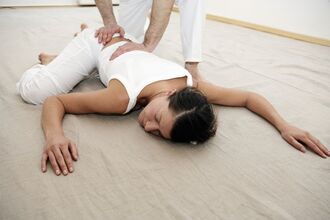
Shiatsu is my personal favorite massage modalities to receive and give for both myself and my clients that I enjoy thoroughly due to its peaceful nature. It is a unique and interesting modality with a history in both Japan and China
What the heck is shiatsu?
This is a type of massage therapy that was primarily developed in Japan It was introduced to the country in the 6th century by a Buddhist monk, according to the Shiatsu Society. With its name derived from the Japanese term for "finger pressure," it involves applying pressure to specific acupressure points on the body, moving from one point to another in a rhythmic sequence. While shiatsu has roots in traditional Chinese medicine (TCM), it's now commonly practiced throughout the world.
Do you keep your clothes on?
Yes, that's right, shiatsu is typically performed fully clothed while lying on a mat or mattress with a specific sequence of stretching. Some therapists prefer to work with draping though and fuse shiatsu into their regular style of massage as well.
How Does Shiatsu Work?
As in acupressure, practitioners of shiatsu apply pressure to points on the body thought to be connected to pathways called "meridians." By stimulating these points, such therapists aim to promote the flow of vital energy (also known as "chi") and facilitate healing. According to the principles of TCM, blockages in the flow of chi can contribute to a wide range of illnesses.
Although scientists have yet to determine how or why shiatsu might improve health, it's theorized that the treatment may calm the sympathetic nervous system and—in turn—stimulate circulation, reduce stress, and soothe pain.
What Does Shiatsu Feel Like?When performing shiatsu, therapists apply deep pressure using their fingers, thumbs, and/or palms in a continuous sequence. The finger pads are used to apply pressure, and each point is typically held for two to eight seconds.
Acupressure Points:
In some cases, the pressure points stimulated during shiatsu may feel tender. Those receiving shiatsu often describe this tenderness as "good pain," but it's important to alert your therapist if you feel discomfort or pain during your massage. Your therapist can then adjust the pressure to make the massage more comfortable for you.
Shiatsu is typically done on a low massage table or on a mat on the floor. Although the sequence is often similar to other types of massage, no massage oil is used, so it is usually done with the client fully clothed in loose, comfortable clothing.
Uses for Shiatsu: Why Do People Get It?
Shiatsu is often used to lessen stress and protect against stress-related health issues. In addition, shiatsu is said to promote healing in conditions like anxiety, arthritis, back pain, constipation, headache, insomnia, menstrual problems, neck and shoulder pain, premenstrual syndrome, sciatica, and sinus problems.
Shiatsu is also said to increase energy, promote recovery from injuries, and stimulate the digestive system.
If you're thinking of using any type of massage therapy (including shiatsu) to manage a health problem, make sure to talk to your primary care provider first to discuss whether it's right for you.
The Benefits of Shiatsu: Can It Really Help?Research on the health effects of shiatsu is fairly limited, but there's some evidence that it may offer certain benefits.
For example, a study published in the Journal of Alternative and Complementary Medicine in 2008 suggests that shiatsu may help reduce stress and alleviate fatigue. In a survey of 633 people who had recently completed six months of shiatsu treatments, the study's authors also found that shiatsu may help ease symptoms associated with muscle and joint problems.
Some research also indicates that shiatsu shows promise in the treatment of certain pain-causing conditions.
In a report published in Manual Therapy in 2015, for instance, shiatsu was found to improve pain intensity and quality of life for people with fibromyalgia.
For this report, researchers analyzed previously published clinical trials on massage for fibromyalgia. Their analysis determined that shiatsu improved pain, pressure pain threshold, fatigue, sleep, and quality of life. Some of the different styles of Shiatsu include:
- Zen
- Macrobiotic
- Seiki
- Healing
- Namikoshi
- Movement
- Hara
In addition to being a deeply relaxing experience, Shiatsu massage therapy helps treat a variety of different health problems using a holistic and integrative approach. Some of the conditions the technique helps treat include:
- Poor posture
- Joint problems
- Carpal Tunnel
- Sprains
- Arthritis
- Sciatica
- Acute
- Chronic neck and back pain
- Sinusitis
- Bronchitis
- Stress
- Sleep Issues
- Blood pressure irregularities
Table Thai Massage
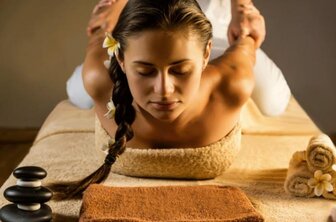
Thai Massage is an ancient form of massage thought to have been developed by Buddhist monks in Thailand 2,500 years ago. It uses passive stretching and gentle pressure along the body’s energy lines to increase flexibility, relieve muscle and joint tension and balance the body’s energy systems. Traditional Thai massage uses no oils or lotions. There is constant body contact between the giver and receiver, but rather than rubbing on muscles, the body is compressed, pulled, stretched and rocked. The recipient lies either on the table (table thai massage), or on a mat or firm mattress on the floor. The receiver will be positioned in a variety of yoga-like positions during the course of the massage, that is also combined with deep static and rhythmic pressures.
The massage generally follows designated lines ("sen") in the body. The legs and feet of the giver can be used to position the body or limbs of the recipient. In other positions, hands fix the body, while the feet do the massaging. A full Thai massage session may last two hours and includes rhythmic pressing and stretching of the entire body. This may include pulling fingers, toes, ears, cracking knuckles, walking on the recipient's back, and moving the recipient's body into many different positions. There is a standard procedure and rhythm to the massage, which the giver adjusts to fit the receiver.
Benefits of Thai massage
The end result is a heightened sense of well-being and optimum relaxation.The founder of Thai massage and medicine is said to have been Shivago Komarpaj who is said in the Pāli Buddhist canon to have been the Buddha's physician over 2,500 years ago. He is noted in ancient documents for his extraordinary medical skills, his knowledge of herbal medicine, and for having treated important people of his day, including the Buddha himself. In fact, the history of Thai massage is more complex than this legend of a single founder would suggest. Thai massage is a combination of influences from Indian, Chinese, Southeast Asian cultural spheres, and traditions of medicine, and the art as it is practiced today is likely to be the product of a 19th-century synthesis of various healing traditions from all over the kingdom. Even today, there is considerable variation from region to region across Thailand, and no single routine or theoretical framework that is universally accepted among healers
Thai massage is one of my top go-to options for preventing and remedying back ailments. More dynamic and rigorous than your usual massage, limbs and joints are manipulated in a sequence of movements, inspired by yogic stretching.
This makes Thai massage particularly beneficial to athletes and individuals with active lifestyles and spiritual practices.
The massage generally follows designated lines ("sen") in the body. The legs and feet of the giver can be used to position the body or limbs of the recipient. In other positions, hands fix the body, while the feet do the massaging. A full Thai massage session may last two hours and includes rhythmic pressing and stretching of the entire body. This may include pulling fingers, toes, ears, cracking knuckles, walking on the recipient's back, and moving the recipient's body into many different positions. There is a standard procedure and rhythm to the massage, which the giver adjusts to fit the receiver.
Benefits of Thai massage
- 1. Reduces Muscle Tension & Spasms
- 2. Mobilizes the Joints
- 3. Improves blood Circulation
- 4. Balances and Increases Energy
- 5. Can Treat Sciatica, Headaches & Neck Pain
The end result is a heightened sense of well-being and optimum relaxation.The founder of Thai massage and medicine is said to have been Shivago Komarpaj who is said in the Pāli Buddhist canon to have been the Buddha's physician over 2,500 years ago. He is noted in ancient documents for his extraordinary medical skills, his knowledge of herbal medicine, and for having treated important people of his day, including the Buddha himself. In fact, the history of Thai massage is more complex than this legend of a single founder would suggest. Thai massage is a combination of influences from Indian, Chinese, Southeast Asian cultural spheres, and traditions of medicine, and the art as it is practiced today is likely to be the product of a 19th-century synthesis of various healing traditions from all over the kingdom. Even today, there is considerable variation from region to region across Thailand, and no single routine or theoretical framework that is universally accepted among healers
Thai massage is one of my top go-to options for preventing and remedying back ailments. More dynamic and rigorous than your usual massage, limbs and joints are manipulated in a sequence of movements, inspired by yogic stretching.
This makes Thai massage particularly beneficial to athletes and individuals with active lifestyles and spiritual practices.
Sports Massage
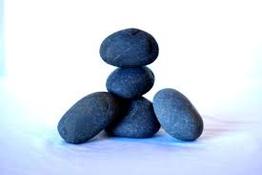
Sports massage is not a specific technique, but the application of several methods for achieving a sport specific goals. It can be used to recover after a competition or big workout, to treat or prevent an injury, as well as increase performance.
Sports massage involves soft tissue manipulation that is done with the intent to improve the athlete’s body.
Developed to help with muscle systems used for a particular sport, sports massage uses a variety of approaches to help athletes in training -- before, during, or after sports events. You might use it to promote flexibility and help prevent injuries. Or, it may help muscle strains, aiding healing after a sports injury.
The focus of sports massage is to improve circulation, flexibility and range of motion, decrease recovery time from training, prevent injury, and improve muscular efficiency which will result in better performance.
Russian massage is a massage therapy technique developed in the former Soviet Union. It’s most often classified as a sports massage. Russian massage is sometimes referred to as connective tissue massage, point massage, or reflexology massage, depending on the techniques used during treatment.
One basic but important thing about sports massage is that it allows the body to regain proper alignment and function. There may be some pain affiliated initially, but when done correctly, it can be a good pain you want to work through. Sports massage has an immeasurable physical and psychological effect on the body and mind that should not be underestimated.
Sports massage involves soft tissue manipulation that is done with the intent to improve the athlete’s body.
Developed to help with muscle systems used for a particular sport, sports massage uses a variety of approaches to help athletes in training -- before, during, or after sports events. You might use it to promote flexibility and help prevent injuries. Or, it may help muscle strains, aiding healing after a sports injury.
The focus of sports massage is to improve circulation, flexibility and range of motion, decrease recovery time from training, prevent injury, and improve muscular efficiency which will result in better performance.
Russian massage is a massage therapy technique developed in the former Soviet Union. It’s most often classified as a sports massage. Russian massage is sometimes referred to as connective tissue massage, point massage, or reflexology massage, depending on the techniques used during treatment.
One basic but important thing about sports massage is that it allows the body to regain proper alignment and function. There may be some pain affiliated initially, but when done correctly, it can be a good pain you want to work through. Sports massage has an immeasurable physical and psychological effect on the body and mind that should not be underestimated.
Acupressure
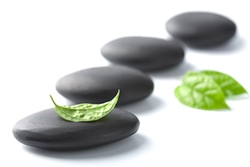
Acupressure is an ancient Chinese healing method that is translated into "finger pressure" and involves applying pressure to certain meridian points on the body to relieve pain. The human body has fourteen “meridians” that carry energy throughout the body. These meridians start at the fingertips, connect to the brain, and then connect to the organ associated with the specific meridian.
Acupuncture and Acupressure use the same points, but acupuncture uses needles, while Acupressure uses the gentle but firm pressure of hands. There is a massive amount of scientific data that demonstrates why and how acupressure works to help relieve pain and inflammation in the body.
It is the most effective method for self-treatment of tension-related ailments by using the power and sensitivity of the human hand. Acupressure deals with all the aspects of a person as a whole: body, emotions, mind, and spirit as one, not as separate parts. It relaxes muscular tension and balances the vital life forces of the body.
Acupuncture and acupressure use the same pressure points and meridians, but Acupuncture employs needles, while Acupressure uses gentle to firm finger pressure. When these acupressure points are stimulated, they release muscular tension, promote circulation of blood, and enhance the body's life force energy to aid healing. Acupressure therapy can be used to relieve pain, calm the nervous system, fortify the reproductive system, detoxify the body for greater health and beauty, and tone facial and back muscles.
Common Benefits of Acupressure:
• Relieves stress and tension
• Relax mind and body
• Increase blood circulation
• Aid in the removal of toxic wastes
• Provide relief from head, neck and shoulder aches
• Promote the healing of injuries
• Increase energy levels
• Increase overall feeling of well-being
• Decreasing labor pains
According to Traditional Chinese Medicine, there are over 800 vital energy points along the meridians that run from the head down to the heels, especially along either side of the spinal column. (The meridians connect the interior and exterior of the body). Every point has specific therapeutic effects on the related organ. By massaging these points, the corresponding body area receives specific therapeutic treatment. It can be used to treat internal organ diseases, relieve internal discomfort, and relax yourself; or to promote overall well-being of the body. I personally believe firmly in acupressure because over the years it has helped to relieve pain and heal my body as well as so many others that I have seen and helped to orchestrate myself.
Acupuncture and Acupressure use the same points, but acupuncture uses needles, while Acupressure uses the gentle but firm pressure of hands. There is a massive amount of scientific data that demonstrates why and how acupressure works to help relieve pain and inflammation in the body.
It is the most effective method for self-treatment of tension-related ailments by using the power and sensitivity of the human hand. Acupressure deals with all the aspects of a person as a whole: body, emotions, mind, and spirit as one, not as separate parts. It relaxes muscular tension and balances the vital life forces of the body.
Acupuncture and acupressure use the same pressure points and meridians, but Acupuncture employs needles, while Acupressure uses gentle to firm finger pressure. When these acupressure points are stimulated, they release muscular tension, promote circulation of blood, and enhance the body's life force energy to aid healing. Acupressure therapy can be used to relieve pain, calm the nervous system, fortify the reproductive system, detoxify the body for greater health and beauty, and tone facial and back muscles.
Common Benefits of Acupressure:
• Relieves stress and tension
• Relax mind and body
• Increase blood circulation
• Aid in the removal of toxic wastes
• Provide relief from head, neck and shoulder aches
• Promote the healing of injuries
• Increase energy levels
• Increase overall feeling of well-being
• Decreasing labor pains
According to Traditional Chinese Medicine, there are over 800 vital energy points along the meridians that run from the head down to the heels, especially along either side of the spinal column. (The meridians connect the interior and exterior of the body). Every point has specific therapeutic effects on the related organ. By massaging these points, the corresponding body area receives specific therapeutic treatment. It can be used to treat internal organ diseases, relieve internal discomfort, and relax yourself; or to promote overall well-being of the body. I personally believe firmly in acupressure because over the years it has helped to relieve pain and heal my body as well as so many others that I have seen and helped to orchestrate myself.
Cupping
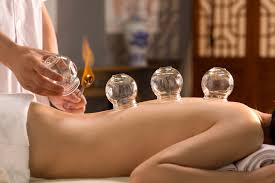
What is cupping?
Cupping therapy is an alternative therapeutic method that has been popular in China since around 1000 B.C. Some records show that variations of cupping practices might actually be much older — possibly dating as far back as 3000 B.C. And for good reason. Cupping therapy has a host of health benefits that can often outweigh modern medicine techniques.
One of the biggest advantages to trying alternative practices like cupping therapy and massage therapy is that these methods don’t pose the risk for unwanted side effects like pharmacological drugs or surgery do.
In fact, there’s really no downside to trying alternative practices like cupping, since studies show they can help boost the immune system and speed up healing time without the use of any medications or even herbs. Cupping is very popular for athletes for muscle recovery before and after very intense training or work out sessions.
These are just some of the benefits of cupping therapy.
Benefits of Cupping Therapy:
Most of the validity of cupping as an alternative medical practice comes from its long history of use over the past 3,000 years. Cupping techniques have been used extensively to treat a range of disorders and symptoms, sometimes on their own, or other times in conjunction with other alternative practices. It’s common for cupping therapy to be used along with massage therapy, essential oils, acupuncture or even as an adjunct to “Western medicine” treatments.
What we do know from the limited scientific studies that have been done is that cupping works by expanding the capillaries and increasing the amount of fluid entering and leaving tissues. Besides this, cupping therapy seems to provoke a relaxation response in some people, which means it’s useful for lowering stress and its negative effects.
While there’s a ton of anecdotal evidence that cupping can be effective and safe, to date very few clinical studies using humans have been conducted, making it hard to “prove” many of the time-honored benefits of cupping therapy. That being said, it’s worked for millions of people over many years, so here are five ways that cupping might be able to help you:
1. Helps Reduce Pain: One of the most common reasons people turn to alternative treatment methods is because they’re looking for a safe way to naturally reduce joint pain, inflammation and muscle pain. After reviewing dozens of randomized clinical trials testing cupping therapy in patients with pain of any origin, a report published in Evidence-Based Complimentary and Alternative Medicine found that cupping significantly reduced pain in people with low back issues compared to usual care treatments, showed positive effects in treating cancer pain compared with anticancer drugs and analgestics, and helped soothe pain associated with respiratory issues.
Cupping is thought to release tissues deep inside the body, relax tense muscles and ease stiffness associated with chronic back and neck pains, migraines, rheumatism, and fatigue. Some athletes have been known to use cupping therapy to naturally improve performance and reduce stiffness, muscle cramps, joint pains and scar tissue caused by injuries.
Cupping targets soft tissue by applying local pressure to pain points and areas of swelling. As blood flow increases within vessels and capillaries, tissues receive much-needed nutrients and oxygen. Cupping practitioners use pressure, heat, suctioning and needles above or below the site of injury, allowing for energy to travel along the “channels” (meridians) that pass through the injury.
For help lowering pain, cups are commonly placed over the following areas: over the fleshy part of the shoulder blades, over the groin/loins, by the neck (for soothing tension headaches, toothaches, or migraines) or around the lower back.
2. Promotes Relaxation: It might seem counteractive, but cupping often helps alleviate physical complaints and allows people to enter a more relaxed state since it sedates the central nervous system. This is similar to acupuncture, which you might assume hurts and is uncomfortable but actually seems to help lower most patients’ stress responses and therefore offers protection against anxiety and depression.
How can cupping be relaxing? Just the act of laying still and being “taken care of” during cupping therapy sessions might have a positive effect on someone’s psychological well-being, which could be one reason why it’s used to lower mental illnesses. Once the cups are placed down and suctioned, they might need to remain still for up to 20 minutes, which forces stillness and silence on patients who might otherwise lead very hectic lives. Another reason cupping is soothing is because the cups help lift pressure in tense muscles, which offers a relieving sensation just like receiving a deep tissue massage.
3. Boosts Skin Health: Cupping is used to reduce herpes, cellulite, acne and skin inflammation. While studies haven’t shown it can necessarily help with weight loss, the fact that it tones and firms skin by improving blood flow and expanding capillaries makes it popular among celebrities and people in the spotlight who want to appear to have toned skin. As part of a skin-clearing or cellulite treatment, oil is commonly first applied to the skin before the cups are suctioned and moved around, bringing heat to the area along with various skin-healing ingredients depending on the type of oil used.
Because cupping improves blood flow and might help lower inflammation, some studies have found it to be equally or even more effective at treating acne compared to antibiotics.
4. Helps Treat Respiratory Issues and Colds: Commonly used to help nourish the lungs and clear away phlegm or
congestion, cupping therapy can be useful for speeding up healing time from respiratory illnesses like the flue or common colds. Cupping helps improve immune function by moving blood and lymphatic fluid throughout the body, which is why it’s been associated with reductions in lung diseases (especially chronic coughs), allergies, infections and asthma.
Treating respiratory conditions like pulmonary tuberculosis is one of the oldest uses for cupping and was utilized long before prescriptions were available.
5. Improves Digestion: Acupuncture and cupping are both popular ways to improve digestion and reduce symptoms from disorders like irritable bowel syndrome (IBS). This might primarily be because they can lower a patient’s stress response, which is highly tied to healthy digestive functioning.
Throughout history, cupping therapy has been found to be beneficial for people with frequent stomach pains, diarrhea, acute gastritic, loss of appetite, gastrointestinal diseases and water retention. For digestive disturbances, cupping is commonly performed in the following areas: around the navel, over the bladder, around the kidneys or over the stomach.
The suction and negative pressure provided by cupping can loosen muscles, encourage blood flow, and sedate the nervous system (which makes it an excellent treatment for high blood pressure). Cupping is used to relieve back and neck pains, stiff muscles, anxiety, fatigue, migraines, rheumatism, and even cellulite.
Cupping therapy is an alternative therapeutic method that has been popular in China since around 1000 B.C. Some records show that variations of cupping practices might actually be much older — possibly dating as far back as 3000 B.C. And for good reason. Cupping therapy has a host of health benefits that can often outweigh modern medicine techniques.
One of the biggest advantages to trying alternative practices like cupping therapy and massage therapy is that these methods don’t pose the risk for unwanted side effects like pharmacological drugs or surgery do.
In fact, there’s really no downside to trying alternative practices like cupping, since studies show they can help boost the immune system and speed up healing time without the use of any medications or even herbs. Cupping is very popular for athletes for muscle recovery before and after very intense training or work out sessions.
These are just some of the benefits of cupping therapy.
Benefits of Cupping Therapy:
Most of the validity of cupping as an alternative medical practice comes from its long history of use over the past 3,000 years. Cupping techniques have been used extensively to treat a range of disorders and symptoms, sometimes on their own, or other times in conjunction with other alternative practices. It’s common for cupping therapy to be used along with massage therapy, essential oils, acupuncture or even as an adjunct to “Western medicine” treatments.
What we do know from the limited scientific studies that have been done is that cupping works by expanding the capillaries and increasing the amount of fluid entering and leaving tissues. Besides this, cupping therapy seems to provoke a relaxation response in some people, which means it’s useful for lowering stress and its negative effects.
While there’s a ton of anecdotal evidence that cupping can be effective and safe, to date very few clinical studies using humans have been conducted, making it hard to “prove” many of the time-honored benefits of cupping therapy. That being said, it’s worked for millions of people over many years, so here are five ways that cupping might be able to help you:
1. Helps Reduce Pain: One of the most common reasons people turn to alternative treatment methods is because they’re looking for a safe way to naturally reduce joint pain, inflammation and muscle pain. After reviewing dozens of randomized clinical trials testing cupping therapy in patients with pain of any origin, a report published in Evidence-Based Complimentary and Alternative Medicine found that cupping significantly reduced pain in people with low back issues compared to usual care treatments, showed positive effects in treating cancer pain compared with anticancer drugs and analgestics, and helped soothe pain associated with respiratory issues.
Cupping is thought to release tissues deep inside the body, relax tense muscles and ease stiffness associated with chronic back and neck pains, migraines, rheumatism, and fatigue. Some athletes have been known to use cupping therapy to naturally improve performance and reduce stiffness, muscle cramps, joint pains and scar tissue caused by injuries.
Cupping targets soft tissue by applying local pressure to pain points and areas of swelling. As blood flow increases within vessels and capillaries, tissues receive much-needed nutrients and oxygen. Cupping practitioners use pressure, heat, suctioning and needles above or below the site of injury, allowing for energy to travel along the “channels” (meridians) that pass through the injury.
For help lowering pain, cups are commonly placed over the following areas: over the fleshy part of the shoulder blades, over the groin/loins, by the neck (for soothing tension headaches, toothaches, or migraines) or around the lower back.
2. Promotes Relaxation: It might seem counteractive, but cupping often helps alleviate physical complaints and allows people to enter a more relaxed state since it sedates the central nervous system. This is similar to acupuncture, which you might assume hurts and is uncomfortable but actually seems to help lower most patients’ stress responses and therefore offers protection against anxiety and depression.
How can cupping be relaxing? Just the act of laying still and being “taken care of” during cupping therapy sessions might have a positive effect on someone’s psychological well-being, which could be one reason why it’s used to lower mental illnesses. Once the cups are placed down and suctioned, they might need to remain still for up to 20 minutes, which forces stillness and silence on patients who might otherwise lead very hectic lives. Another reason cupping is soothing is because the cups help lift pressure in tense muscles, which offers a relieving sensation just like receiving a deep tissue massage.
3. Boosts Skin Health: Cupping is used to reduce herpes, cellulite, acne and skin inflammation. While studies haven’t shown it can necessarily help with weight loss, the fact that it tones and firms skin by improving blood flow and expanding capillaries makes it popular among celebrities and people in the spotlight who want to appear to have toned skin. As part of a skin-clearing or cellulite treatment, oil is commonly first applied to the skin before the cups are suctioned and moved around, bringing heat to the area along with various skin-healing ingredients depending on the type of oil used.
Because cupping improves blood flow and might help lower inflammation, some studies have found it to be equally or even more effective at treating acne compared to antibiotics.
4. Helps Treat Respiratory Issues and Colds: Commonly used to help nourish the lungs and clear away phlegm or
congestion, cupping therapy can be useful for speeding up healing time from respiratory illnesses like the flue or common colds. Cupping helps improve immune function by moving blood and lymphatic fluid throughout the body, which is why it’s been associated with reductions in lung diseases (especially chronic coughs), allergies, infections and asthma.
Treating respiratory conditions like pulmonary tuberculosis is one of the oldest uses for cupping and was utilized long before prescriptions were available.
5. Improves Digestion: Acupuncture and cupping are both popular ways to improve digestion and reduce symptoms from disorders like irritable bowel syndrome (IBS). This might primarily be because they can lower a patient’s stress response, which is highly tied to healthy digestive functioning.
Throughout history, cupping therapy has been found to be beneficial for people with frequent stomach pains, diarrhea, acute gastritic, loss of appetite, gastrointestinal diseases and water retention. For digestive disturbances, cupping is commonly performed in the following areas: around the navel, over the bladder, around the kidneys or over the stomach.
The suction and negative pressure provided by cupping can loosen muscles, encourage blood flow, and sedate the nervous system (which makes it an excellent treatment for high blood pressure). Cupping is used to relieve back and neck pains, stiff muscles, anxiety, fatigue, migraines, rheumatism, and even cellulite.
Gua Sha Facial Scraping
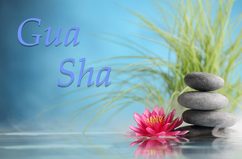
“Gua sha is a healing technique of traditional East Asian medicine. Sometimes called ‘coining, spooning or scraping’, Gua sha is defined as instrument-assisted unidirectional press-stroking of a lubricated area of the body surface to intentionally create transitory therapeutic petechiae called ‘sha’ representing extravasation of blood in the subcutis.” (Nielsen, 2013)
Meridian Scraping/Gua sha is an ancient East Asian healing technique taught by only a handful of Western practitioners. In China and Vietnam, scraping is commonly used to relieve the aches and fever associated with the common cold. The Greeks used a similar technique in their daily massage regiments to invigorate the blood and relieve pain. Scraping therapy can be used to address various sorts of conditions. Most commonly used to treat body pain, to boost the immune system and to relieve symptoms of the common cold, this modality can also be used to generally balance the flow of qi through the meridians, to resolve certain psychospiritual issues and to innervate areas of poor circulation such as adipose tissue which can have both a detoxifying and contouring effect. Gua sha provides lasting relief for chronic pain and it gives almost instantaneous relief from pain and congestion as well as freeing up a greater range of movement in joints and ligaments.
Meridian Scraping/Gua sha is an ancient East Asian healing technique taught by only a handful of Western practitioners. In China and Vietnam, scraping is commonly used to relieve the aches and fever associated with the common cold. The Greeks used a similar technique in their daily massage regiments to invigorate the blood and relieve pain. Scraping therapy can be used to address various sorts of conditions. Most commonly used to treat body pain, to boost the immune system and to relieve symptoms of the common cold, this modality can also be used to generally balance the flow of qi through the meridians, to resolve certain psychospiritual issues and to innervate areas of poor circulation such as adipose tissue which can have both a detoxifying and contouring effect. Gua sha provides lasting relief for chronic pain and it gives almost instantaneous relief from pain and congestion as well as freeing up a greater range of movement in joints and ligaments.
Reflexology Massage
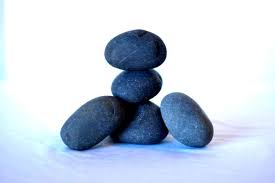
Reflexology is a scientific art based on the premise that there are zones and reflex areas in the feet and hands which correspond to all body parts. These areas are believed to correspond to different parts of the body. The physical act of applying specific pressures using thumb, finger and hand techniques result in stress reduction which causes a physiological change in the body. The massage, then, is expected to promote health and well-being.
Reflexology is a holistic energy-based modality, working through the energies of the nervous, electrical, chemical and magnetic systems of the body. It utilizes manual techniques unique to the field of Reflexology. These techniques are applied to reflex maps resembling the human body, which are believed to exist on the feet and hands and correlate to the organs and the rest of the body when stimulated.
Some of the benefits of reflexology include its ability to stimulate nerve function, increases energy, boosts circulation, induces a deep state of relaxation, eliminates toxins, stimulates the central nervous system, prevents migraines, cleans up urinary tract conditions, speeds recovery after injury or surgery, helps relieve sleep disorders, reduces depression, and relieves pain. It can also help to ease the treatment of various cancer and even helps to soothe the pains of pregnancy, even those occurring after the baby is born.
One of the most well-known and verified benefits of reflexology is an improvement in circulation throughout the body, which means that blood and oxygen are being cycled through the body more effectively. This means more oxygen reaches vital organ systems, thereby optimizing their functioning and further increasing the metabolism. This also results in faster healing and re-growth of damaged cells.
By aligning the functioning of various organ and muscle systems, reflexology can increase metabolism and energy creation processes within the body. If you need a boost in energy or are always feeling sluggish, perhaps a reflexology session can help put some pep back in your step!
Reflexology is a holistic energy-based modality, working through the energies of the nervous, electrical, chemical and magnetic systems of the body. It utilizes manual techniques unique to the field of Reflexology. These techniques are applied to reflex maps resembling the human body, which are believed to exist on the feet and hands and correlate to the organs and the rest of the body when stimulated.
Some of the benefits of reflexology include its ability to stimulate nerve function, increases energy, boosts circulation, induces a deep state of relaxation, eliminates toxins, stimulates the central nervous system, prevents migraines, cleans up urinary tract conditions, speeds recovery after injury or surgery, helps relieve sleep disorders, reduces depression, and relieves pain. It can also help to ease the treatment of various cancer and even helps to soothe the pains of pregnancy, even those occurring after the baby is born.
One of the most well-known and verified benefits of reflexology is an improvement in circulation throughout the body, which means that blood and oxygen are being cycled through the body more effectively. This means more oxygen reaches vital organ systems, thereby optimizing their functioning and further increasing the metabolism. This also results in faster healing and re-growth of damaged cells.
By aligning the functioning of various organ and muscle systems, reflexology can increase metabolism and energy creation processes within the body. If you need a boost in energy or are always feeling sluggish, perhaps a reflexology session can help put some pep back in your step!
Foot Massage
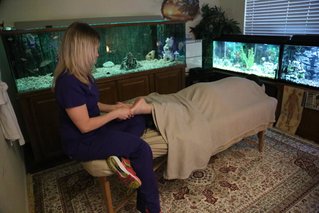
I also offer a relaxing foot massage after soaking my client's feet in warm water with epsom salt and essential oils designed to soothe and relax your sore and tired feet. Foot massage can really help us relax, particularly after a long day of standing up and walking around, when our feet tend to swell up. Sure, everyone enjoys it, but does it really have any benefits other than making us feel a bit more relaxed and relieving some of the pain?There are a several different massage techniques that all promise certain health benefits. Traditional therapeutic techniques focus on relaxing the muscles and joints; acupressure seeks to improve general health and energy flow by acting upon specific pressure points; aromatherapy uses scented oils and relaxing music to add an additional element of relaxation by acting upon multiple senses; and reflexology seeks to improve internal organ function by massaging specific areas of the foot.
There are many claims, some fairly outrageous, about what a simple massage can do for you, but there is very little evidence to support them. We will take a look at some of the benefits of foot massage that are supported by actual scientific research – benefits that are either immediate or can be seen and felt after a couple of weeks.
1. Relaxation and Stress Relief: Any type of massage can be relaxing, and can help you let go of the stress you are carrying in your body. Many people tend to consider the neck, shoulders and back as the primary places to massage when looking for stress relief.
But a foot massage can be just as effective at easing your worries. Research has found that staff who took care of dementia patients – a stressful and demanding role – experienced lower levels of anxiety and better moods after just ten minutes of foot massage.
Earlier research has also found that a five minute foot massage helped relax and reduce stress in critical care patients; while a hand or foot rub was seen to bring emotional comfort to those grieving the death of a loved one.
2. Better Sleep: Just one of the incredible benefits of reflexology is its ability to help you overcome disturbed sleeping patterns and insomnia. Massaging your feet before you go to bed will help you relax and let go of the day’s stresses. To enjoy a really deep sleep, pay special attention to the solar plexus reflex which houses a lot of your stress.
The solar plexus can be found if you gently squeeze the top of the foot inward and search for a little dimpled space. Press and massage this area for a blissful night’s rest.
3. Improved Circulation: Thanks to our sedentary lifestyle, lack of exercise and restrictive footwear our circulation is often impaired.
Ever endure cold or numb feet? Get a tingling in your toes for no reason? Or perhaps you suffer chilblains. These are all signs of poor circulation in the feet – something which can be greatly improved upon with regular foot massages.
4. Lower Blood Pressure: High blood pressure, or hypertension, is a serious condition that can increase your risk of suffering a heart attack, stroke or kidney failure.
Lifestyle changes – including eating the right foods – can lower your blood pressure levels significantly, as can regularly massaging your feet. A Korean study found that systolic blood pressure and blood triglyceride levels were both improved following a relaxing foot massage. Other research discovered that hypertensive patients receiving reflexology treatments specifically targeted at reflexes to reduce blood pressure enjoyed so much improvement in their symptoms that they were able to reduce dosages of their high blood pressure medications while undergoing the massage therapy!
5. Injury Prevention and Faster Recovery: Massaging the feet can help with joint pain and aid recovery after an injury, as well as reduce muscle soreness.It can also prevent future injuries such as plantar fasciitis – one of the most common causes of heel pain which sees the thick band of tissue running across the bottom of your foot and connecting your heel bone to your toe becoming painful and inflamed.
Too much standing, running, sports involving lots of jumping or hard landing, being overweight and wearing shoes with inadequate support all put you at risk of plantar fasciitis.
6. Alleviation of Headaches and Migraines: If you suffer frequent headaches and migraines, give reflexology and foot massage a go.
Danish research, published in Alternative Therapies in Health and Medicine, followed the response of 220 patients to six months of reflexology.After just three months , 81% of the patients claimed that the foot massages either considerably helped or completely healed their headache problems, and 19% who previously took medication to manage their condition were able to stop taking it!
7. Decreased Feelings of Anxiety: Anxiety disorders are the most common mental illness in the US, affecting 40 million adults – that’s just under one fifth of the population!Natural remedies for anxiety can be incredibly effective, as studies have demonstrated. In 2002, 67 menopausal women were given nine sessions of either reflexology or non-specific foot massage.
Even though the reflexology was not shown to be any more effective than non-specific foot massage in the treatment of psychological symptoms during the menopause, it still led to a 50% decrease in feelings of anxiety, which surpassed the control group two-fold.
8. Natural Pain Relief: Tired and aching feet can always benefit from a foot rub but did you know that the pain relieving powers of massage don’t end there? Foot massage can actually kill pain in other areas of the body too. Research from 2004 discovered that patients who had just undergone an operation enjoyed greater pain relief after a hand or foot massage than did those patients who were only given pain medication alone. More recent research showed that women who gave birth by C-section reported reduced pain after foot massages than those who did not receive the massage.
9. Nail and Skin Health: Regularly using moisturizing natural oils and antimicrobial essential oils on your feet is a fantastic way to ensure healthy, happy skin and nails. Using coconut oil or almond oil can prevent dry, cracked and painful heels that lead to fissures and infections, as well as stopping thick calloused skin forming. Your nails and cuticles will also stay hydrated.
What’s more, regularly using essential oils like tea tree, lavender, or eucalyptus will help you avoid bacterial and fungal infections of the nails and skin, including Athlete’s Foot.
10. Cure for Swelling of the Legs: Swelling of the legs and feet due to fluid retention, called edema, can often follow on from long periods of sitting or standing. It is also common during pregnancy. A study published in the International Journal of Nursing Practice found that pregnancy-related edema was significantly reduced by regular foot massage. In fact, the women in the massage groups had distinctly smaller leg circumferences than did the women in the placebo group.
It’s important to note that leg and ankle swelling can also signal an underlying issue including kidney disease, heart failure, liver disease and more. Always consult your doctor if in doubt.
11. PMS Symptom Relief: Common symptoms of PMS include feelings of sadness, irritability, anxiety, tension, insomnia, fatigue and headaches, with a full 50% of women experiencing pain.Given what we already know about the benefits of foot massage for most of these problems, it should come as no surprise to learn that research backs up the argument for enjoying regular foot massages while experiencing common PMS symptoms. A 1993 Californian study shows that women who underwent reflexology reported reduced PMS symptoms when compared with the placebo group. The 50% of women who experience painful periods (dysmenorrhea) will be happy to hear that reflexology can rival ibuprofen when it comes to relieving this painful condition.
Participants in a 2010 study were treated with either 400 mg of ibuprofen once every eight hours for three days during three consecutive monthly cycles or 10 reflexology sessions at 40 minutes for two consecutive monthly cycles.
During the third month when only ibuprofen was given (and no reflexology), the healing effects of reflexology continued on and actually surpassed the pain management quality of ibuprofen – even though no massages were given that month!
As well as being associated with a greater reduction in both the intensity and duration of menstrual pain over ibuprofen, the reflexology actually seems to promote healing rather than just pain relief.
12. Cure Chronic Sinus Infections: Inflammation and congestion of the sinuses can also be healed through foot massage. When 150 adults with chronic sinusitis were treated with either nasal irrigation or reflexology daily for two weeks, both groups enjoyed significant and equal improvement.70% of the volunteers benefited from the treatments, and 35% reported that they decreased their sinus medication because of the treatments.
13. Relieve Symptoms of Cancer, Diabetes and Multiple Sclerosis: The symptoms of a variety of serious medical conditions can be somewhat alleviated through foot massage. For example, people with diabetic foot ulcers – a major complication of diabetes mellitus – saw a significantly decreased healing time when treated with massage. It is likely this improvement was caused by increased circulation.
Cancer patients enjoyed relief from both pain and nausea when treated to foot massages as part of a study carried out by researchers from the University of Canberra. In addition, breast cancer patients undergoing treatment reported a dramatic decrease in physical symptoms associated with both the illness and the medication, including less shortness of breath and improved energy levels.
Reflexology can also provide relief from the fatigue associated with multiple sclerosis, according to 2015 Iranian research.
According to the reflexology theory, working the entire foot opens nerve pathways and blockages and promotes relaxation throughout the body, leaving you feeling deeply relaxed and decreasing stress and anxiety levels significantly.
There are many claims, some fairly outrageous, about what a simple massage can do for you, but there is very little evidence to support them. We will take a look at some of the benefits of foot massage that are supported by actual scientific research – benefits that are either immediate or can be seen and felt after a couple of weeks.
1. Relaxation and Stress Relief: Any type of massage can be relaxing, and can help you let go of the stress you are carrying in your body. Many people tend to consider the neck, shoulders and back as the primary places to massage when looking for stress relief.
But a foot massage can be just as effective at easing your worries. Research has found that staff who took care of dementia patients – a stressful and demanding role – experienced lower levels of anxiety and better moods after just ten minutes of foot massage.
Earlier research has also found that a five minute foot massage helped relax and reduce stress in critical care patients; while a hand or foot rub was seen to bring emotional comfort to those grieving the death of a loved one.
2. Better Sleep: Just one of the incredible benefits of reflexology is its ability to help you overcome disturbed sleeping patterns and insomnia. Massaging your feet before you go to bed will help you relax and let go of the day’s stresses. To enjoy a really deep sleep, pay special attention to the solar plexus reflex which houses a lot of your stress.
The solar plexus can be found if you gently squeeze the top of the foot inward and search for a little dimpled space. Press and massage this area for a blissful night’s rest.
3. Improved Circulation: Thanks to our sedentary lifestyle, lack of exercise and restrictive footwear our circulation is often impaired.
Ever endure cold or numb feet? Get a tingling in your toes for no reason? Or perhaps you suffer chilblains. These are all signs of poor circulation in the feet – something which can be greatly improved upon with regular foot massages.
4. Lower Blood Pressure: High blood pressure, or hypertension, is a serious condition that can increase your risk of suffering a heart attack, stroke or kidney failure.
Lifestyle changes – including eating the right foods – can lower your blood pressure levels significantly, as can regularly massaging your feet. A Korean study found that systolic blood pressure and blood triglyceride levels were both improved following a relaxing foot massage. Other research discovered that hypertensive patients receiving reflexology treatments specifically targeted at reflexes to reduce blood pressure enjoyed so much improvement in their symptoms that they were able to reduce dosages of their high blood pressure medications while undergoing the massage therapy!
5. Injury Prevention and Faster Recovery: Massaging the feet can help with joint pain and aid recovery after an injury, as well as reduce muscle soreness.It can also prevent future injuries such as plantar fasciitis – one of the most common causes of heel pain which sees the thick band of tissue running across the bottom of your foot and connecting your heel bone to your toe becoming painful and inflamed.
Too much standing, running, sports involving lots of jumping or hard landing, being overweight and wearing shoes with inadequate support all put you at risk of plantar fasciitis.
6. Alleviation of Headaches and Migraines: If you suffer frequent headaches and migraines, give reflexology and foot massage a go.
Danish research, published in Alternative Therapies in Health and Medicine, followed the response of 220 patients to six months of reflexology.After just three months , 81% of the patients claimed that the foot massages either considerably helped or completely healed their headache problems, and 19% who previously took medication to manage their condition were able to stop taking it!
7. Decreased Feelings of Anxiety: Anxiety disorders are the most common mental illness in the US, affecting 40 million adults – that’s just under one fifth of the population!Natural remedies for anxiety can be incredibly effective, as studies have demonstrated. In 2002, 67 menopausal women were given nine sessions of either reflexology or non-specific foot massage.
Even though the reflexology was not shown to be any more effective than non-specific foot massage in the treatment of psychological symptoms during the menopause, it still led to a 50% decrease in feelings of anxiety, which surpassed the control group two-fold.
8. Natural Pain Relief: Tired and aching feet can always benefit from a foot rub but did you know that the pain relieving powers of massage don’t end there? Foot massage can actually kill pain in other areas of the body too. Research from 2004 discovered that patients who had just undergone an operation enjoyed greater pain relief after a hand or foot massage than did those patients who were only given pain medication alone. More recent research showed that women who gave birth by C-section reported reduced pain after foot massages than those who did not receive the massage.
9. Nail and Skin Health: Regularly using moisturizing natural oils and antimicrobial essential oils on your feet is a fantastic way to ensure healthy, happy skin and nails. Using coconut oil or almond oil can prevent dry, cracked and painful heels that lead to fissures and infections, as well as stopping thick calloused skin forming. Your nails and cuticles will also stay hydrated.
What’s more, regularly using essential oils like tea tree, lavender, or eucalyptus will help you avoid bacterial and fungal infections of the nails and skin, including Athlete’s Foot.
10. Cure for Swelling of the Legs: Swelling of the legs and feet due to fluid retention, called edema, can often follow on from long periods of sitting or standing. It is also common during pregnancy. A study published in the International Journal of Nursing Practice found that pregnancy-related edema was significantly reduced by regular foot massage. In fact, the women in the massage groups had distinctly smaller leg circumferences than did the women in the placebo group.
It’s important to note that leg and ankle swelling can also signal an underlying issue including kidney disease, heart failure, liver disease and more. Always consult your doctor if in doubt.
11. PMS Symptom Relief: Common symptoms of PMS include feelings of sadness, irritability, anxiety, tension, insomnia, fatigue and headaches, with a full 50% of women experiencing pain.Given what we already know about the benefits of foot massage for most of these problems, it should come as no surprise to learn that research backs up the argument for enjoying regular foot massages while experiencing common PMS symptoms. A 1993 Californian study shows that women who underwent reflexology reported reduced PMS symptoms when compared with the placebo group. The 50% of women who experience painful periods (dysmenorrhea) will be happy to hear that reflexology can rival ibuprofen when it comes to relieving this painful condition.
Participants in a 2010 study were treated with either 400 mg of ibuprofen once every eight hours for three days during three consecutive monthly cycles or 10 reflexology sessions at 40 minutes for two consecutive monthly cycles.
During the third month when only ibuprofen was given (and no reflexology), the healing effects of reflexology continued on and actually surpassed the pain management quality of ibuprofen – even though no massages were given that month!
As well as being associated with a greater reduction in both the intensity and duration of menstrual pain over ibuprofen, the reflexology actually seems to promote healing rather than just pain relief.
12. Cure Chronic Sinus Infections: Inflammation and congestion of the sinuses can also be healed through foot massage. When 150 adults with chronic sinusitis were treated with either nasal irrigation or reflexology daily for two weeks, both groups enjoyed significant and equal improvement.70% of the volunteers benefited from the treatments, and 35% reported that they decreased their sinus medication because of the treatments.
13. Relieve Symptoms of Cancer, Diabetes and Multiple Sclerosis: The symptoms of a variety of serious medical conditions can be somewhat alleviated through foot massage. For example, people with diabetic foot ulcers – a major complication of diabetes mellitus – saw a significantly decreased healing time when treated with massage. It is likely this improvement was caused by increased circulation.
Cancer patients enjoyed relief from both pain and nausea when treated to foot massages as part of a study carried out by researchers from the University of Canberra. In addition, breast cancer patients undergoing treatment reported a dramatic decrease in physical symptoms associated with both the illness and the medication, including less shortness of breath and improved energy levels.
Reflexology can also provide relief from the fatigue associated with multiple sclerosis, according to 2015 Iranian research.
According to the reflexology theory, working the entire foot opens nerve pathways and blockages and promotes relaxation throughout the body, leaving you feeling deeply relaxed and decreasing stress and anxiety levels significantly.
Pet Massage
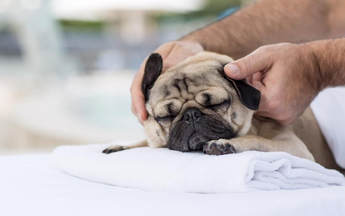
You're kidding, right? Massage for my dog? Your furry family member's health is no joking matter. As humans, we know all too well the benefits of massage. So, do these same principals apply to animals? Of course they do! Pet massage as practiced by a qualified professional is grounded in real science - anatomy, kinesiology and psychology - and has practical applications for a dog's and other animal's physical and mental health.
Since massage looks and feels like pampering, many people automatically discount its value as a serious form of healthcare. Pet owners often fail to realize massage therapy is not merely glorified petting. The skilled manipulation of the soft tissues of the body can have a significant positive impact on virtually all of an animal's biological systems.
Massage affects all systems of the body. Beyond the obvious benefits of relieving muscle tension, it can be a powerful tool for realigning the spine and body. Massage aids in the circulation of fluids throughout the body which assists the joints and muscles flush toxins from the tissues. The results include reduced pain and stiffness, more flexibility and greater range of motion. Massage also increases blood flow, lowers blood pressure and improves cardiovascular health. All of the benefits are simply too numerous to list, but the end result is positive to every system of your pet's body. The recuperative and rehabilitative effects of massage therapy make it ideal for geriatric pets or those recovering from injury or surgery, as well as other benefits:
Many studies suggest that massage stimulates the release of beneficial neurotransmitters and reduces the production of stress hormones. The result is decreased anxiety and an enhanced sense of well being. To keep your best friend healthy, remember to meet all of her needs, not just the physical ones.
Don't overlook the positive results for social and emotional health that massage provides. Dogs are pack animals by nature and thrive on close contact with each other and humans. Consistent massage can help to build a dog's self confidence, sociability and feelings of trust and belonging. These benefits are important to any dog, but priceless for those who have suffered abuse, neglect or other emotional traumas.
Massage is a holistic form of care. It acts upon the entire body in an effort to restore balance and increase an individual's overall wellness. Used in combination with regular veterinary care, massage proves invaluable benefits for your furry family members, reducing anxiety and pain and increasing energy levels and range of motion.
Since massage looks and feels like pampering, many people automatically discount its value as a serious form of healthcare. Pet owners often fail to realize massage therapy is not merely glorified petting. The skilled manipulation of the soft tissues of the body can have a significant positive impact on virtually all of an animal's biological systems.
Massage affects all systems of the body. Beyond the obvious benefits of relieving muscle tension, it can be a powerful tool for realigning the spine and body. Massage aids in the circulation of fluids throughout the body which assists the joints and muscles flush toxins from the tissues. The results include reduced pain and stiffness, more flexibility and greater range of motion. Massage also increases blood flow, lowers blood pressure and improves cardiovascular health. All of the benefits are simply too numerous to list, but the end result is positive to every system of your pet's body. The recuperative and rehabilitative effects of massage therapy make it ideal for geriatric pets or those recovering from injury or surgery, as well as other benefits:
- Reduces pain and/or discomfort from stiffness, inflammation & muscle spasm
- Improves muscle tone, spinal/body alignment, flexibility & range of motion
- Increases energy, concentration and alertness
- Reduces anxiety and stress; eases emotional traumas
- Promotes blood and lymph circulation
- Heightens immune system function
- Aids in healing from surgery or injury
- Builds trust, self-confidence and sociability
- Promotes longevity and slows degenerative processes
- Massage provides overall well-being for your pet. There are MANY additional benefits beyond the ones listed above.
Many studies suggest that massage stimulates the release of beneficial neurotransmitters and reduces the production of stress hormones. The result is decreased anxiety and an enhanced sense of well being. To keep your best friend healthy, remember to meet all of her needs, not just the physical ones.
Don't overlook the positive results for social and emotional health that massage provides. Dogs are pack animals by nature and thrive on close contact with each other and humans. Consistent massage can help to build a dog's self confidence, sociability and feelings of trust and belonging. These benefits are important to any dog, but priceless for those who have suffered abuse, neglect or other emotional traumas.
Massage is a holistic form of care. It acts upon the entire body in an effort to restore balance and increase an individual's overall wellness. Used in combination with regular veterinary care, massage proves invaluable benefits for your furry family members, reducing anxiety and pain and increasing energy levels and range of motion.
Pet Friendly
Location9442 Capital of Texas Highway North, Plaza One, Suite 500
Austin, TX 78759 |
|

